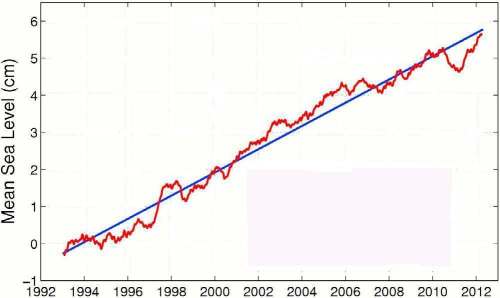Ocean
Surface actually fell
because of La Niña in 2011
Sea
level has been rising slowly for at least 130 years, but
last year the sea level actually fell. Looking at all possible
influences, a team led by Carmen Boening1
at the Jet Propulsion Laboratory in Pasadena, CA, concluded
that the very strong La Niña of 2010–2012 caused
the drop. In general, either cooling of the ocean or
a loss of water would cause sea level to drop. The team
insists that loss of water was responsible. The atmosphere
transported enough water from the sea to the continents
that sea level actually fell by one-half centimeter (5 mm)
worldwide.
The
El Niño-Southern Oscillation (ENSO) is the largest
year-to-year climate signal on Earth2,
according to Dr. Michael McPhaden of
the NOAA Pacific Marine Laboratory in Seattle. El Niño
is the warm phase of this oscillation, and has been shown
to cause temporary rises in sea level. The cold phase, popularly
known as La Niña, may similarly cause sea level to
fall for a while.
As
you may see on the figure at right,
sea level began to fall in the middle of 2010 after a long
and fairly steady rise. In that year, the last El Niño
(a strong one) morphed into a strong La Niña that
continued until 2012. Boening’s team was able to separate
the effect of ocean temperature on sea level from the effect
of a gain or loss of water, by combining measurements of
ocean temperature taken by buoys, and satellite observations
of ocean mass and rainfall. The satellites observed increasing
amounts of water stored on land in Australia, Southeast
Asia, and northern South America by the end of 2010. These
regions were coming out of a drought and were receiving
more precipitation than in earlier years.
Continues
|
 |
Above:
Change in sea level (cm) since 1994 over the last twenty
years. Sea level is arbitrarily set to zero in 1994.
Sea level has been rising one centimeter every 3 years,
but fell in 2010–11. |
The
team concluded that ocean temperatures affected sea level
very little in this case, but that enough water was transferred
from the sea to these three land areas, that sea level dropped
by one-half centimeter.
From
the figure, you can see that sea level was already recovering
in 2011 after the sharp drop in 2010, even though La Niña
continued through 2011. Because the excess water was running
off the land in streams and rivers, such a drop in sea level
is only temporary. The century-long rise of global sea level
is back on track.
CITATIONS
Top
1. The
2011 La Niña: So strong, the oceans fell”
by Carmen Boening and four others (2012). Geophysical
Research Letters, vol. 39, L19602, doi:10.1029/2012GL053055;
4 October 2012.
2. “ENSO
as an integrating concept in Earth science” by Michael
J. McPhaden, S. E. Zebiak, and M. H. Glantz (2006). Science,
vol. 314, p. 1740–1745, doi:10.1126/science.1132588.
Return to Home Page
|

